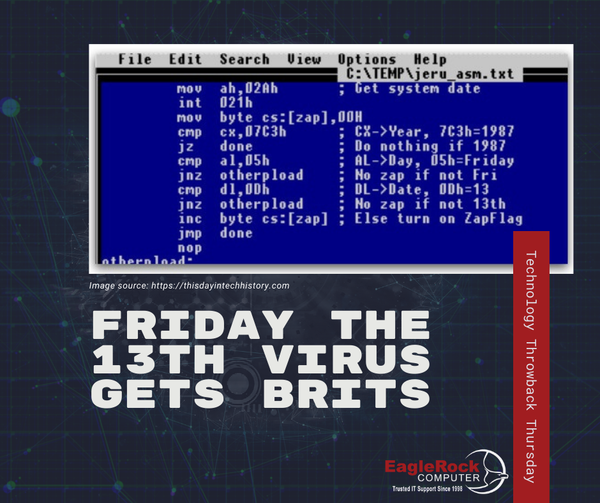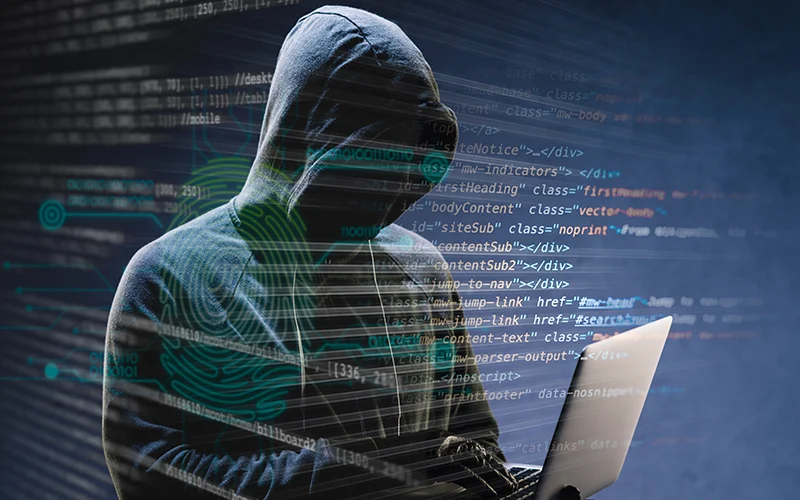In the vast sphere of the digital world, where technology intertwines with our daily lives, the looming threat of cyber-attacks is ever-present. One such notorious event that sent shockwaves through the virtual landscape is the Friday the 13th Virus Strike. This article delves into the intriguing details surrounding this cybersecurity incident, unraveling the mystery behind its terminology and exploring the ramifications it had on online security.
Table of Contents
What is the Friday the 13th virus?
The “Friday the 13th virus” refers to various computer viruses, such as the “Jerusalem” virus in the late 1980s. Named after the superstition surrounding Friday the 13th, these viruses targeted MS-DOS systems, activating and causing disruptions on that specific date. Typically spreading through infected files, they could delete data and compromise system stability. It’s a reminder of early computer security challenges and predating modern, more sophisticated malware, and it highlights the evolution of cybersecurity measures since that time.

Who is the father of computer virus?
The term “father of computer virus” is often attributed to Pakistani computer programmer Basit Farooq Alvi, who, along with his brother Amjad Farooq Alvi, created the first known PC virus in 1986. The virus, known as “Brain,” was relatively harmless, infecting boot sectors of floppy disks. The Alvi brothers created it as a form of copy protection for their medical software. While the Brain virus was not malicious, it marked the beginning of the computer virus era. It’s crucial to note that the term “father of computer virus” is somewhat informal, as computer viruses evolved with contributions from multiple individuals in subsequent years.
The Origins of Friday the 13th Virus Strike
The Fateful Day
The mention of “Friday the 13th” immediately invokes thoughts of superstitions and ominous occurrences. This particular day has long been associated with bad luck in Western superstition, with theories suggesting connections to historical events like the arrest of the Knights Templar on Friday, October 13th, 1307. Over time, the superstitions surrounding Friday the 13th have persisted, leading to a cultural perception that the day is somehow cursed.
Understanding the Virus
The Friday the 13th Virus Strike was a meticulously planned cyber-attack, likely orchestrated by a sophisticated group of hackers or a state-sponsored cyber warfare unit. These entities possessed the expertise and resources to develop a potent computer virus that exploited vulnerabilities in computer systems, spreading as malware through networks and compromising sensitive information. The intentional choice of the name “Friday the 13th” heightened the psychological impact, playing on superstitions to instill fear and uncertainty.
Motive and Aftermath
The attackers’ motives ranged from political espionage to financial gain or causing widespread chaos. Exploiting the psychological impact of the chosen date, they sought to amplify fear and confusion. The aftermath involved significant efforts from organizations, governments, and individuals to contain the damage. Cybersecurity experts and law enforcement globally collaborated to trace the attack’s origin and identify those responsible. Post-incident, there was an increased focus on enhancing global cybersecurity measures, with investments in robust defense mechanisms, intelligence sharing, and international cooperation to mitigate future cyber threats. The Friday the 13th Virus Strike underscored the ever-present digital threats, emphasizing the need for continuous vigilance, collaboration, and innovation in cybersecurity.
The Impact on Cybersecurity

System Vulnerabilities
The Friday the 13th Virus Strike revealed a disturbing level of proficiency in exploiting existing system vulnerabilities. The attackers demonstrated a sophisticated understanding of weaknesses in widely used operating systems and software. This underscored the pressing need for a continuous and proactive approach to identify and patch potential vulnerabilities in digital infrastructure. The incident served as a wake-up call for organizations and governments to invest in robust cybersecurity measures and stay ahead of evolving threats.
Global Reach
The virus exhibited a pervasive global impact, transcending geographical boundaries. Its rapid spread highlighted the interconnected nature of the digital landscape, emphasizing the imperative for international collaboration in cybersecurity efforts. The attack underscored that cyber threats are not confined by borders, necessitating a united front in sharing threat intelligence, developing common defense strategies, and collectively responding to emerging cyber risks.
Economic Consequences
The financial fallout from the Friday the 13th Virus Strike was substantial, with businesses worldwide grappling with unprecedented losses. The attack disrupted operations, compromised sensitive information, and incurred significant recovery costs. This emphasized the economic vulnerabilities inherent in the digital age, prompting organizations to reassess and reinforce their cybersecurity infrastructure. Governments and businesses alike recognized the need for substantial investments in cybersecurity to fortify their defenses against potential future cyber threats, safeguarding both economic stability and the trust of stakeholders.
Lessons Learned and Future Preparedness
Analyzing the Response to the Friday the 13th Virus Strike
Immediate Incident Response
Organizations and cybersecurity experts reacted promptly to contain the Friday the 13th Virus Strike. Incident response teams were activated to identify the scope of the attack, isolate infected systems, and mitigate the impact on critical infrastructure.
Information Sharing
During the incident, there was a notable improvement in information sharing among affected organizations and cybersecurity communities. Sharing threat intelligence and attack indicators helped in developing a unified response strategy and identifying common vulnerabilities.
Public Communication
Transparent communication with the public and stakeholders was crucial. Organizations affected by the attack provided timely updates on the situation, the steps taken to address it, and recommended actions for users to protect themselves.
Strengthening Cybersecurity
Robust Antivirus Solutions
Organizations invested in and implemented more robust antivirus solutions to enhance their defense mechanisms. This included real-time monitoring, behavior analysis, and automatic threat response features to identify and neutralize potential threats quickly.
Cybersecurity Training and Awareness Programs
Recognizing the human element in cybersecurity, organizations prioritized training programs to educate employees about phishing scams, social engineering tactics, and best practices for maintaining a secure digital environment. Fostering a culture of cybersecurity awareness became a key focus.
Regular Security Audits and Vulnerability Assessments
Regular security audits and vulnerability assessments were conducted to identify and address potential weaknesses in systems and networks. This proactive approach helped organizations stay ahead of emerging threats and vulnerabilities.
Collaboration and Information Sharing
Industry-wide Threat Intelligence Sharing
The incident highlighted the need for increased collaboration in sharing threat intelligence across industries. Establishing platforms or frameworks for secure and anonymized information sharing became a priority to enable organizations to learn from each other’s experiences.
Government and Private Sector Cooperation
Governments and private sector entities collaborated more closely to create a united front against cyber threats. This cooperation involved joint initiatives, sharing resources, and developing standardized protocols for responding to and preventing cyber incidents.
International Cooperation
International cooperation increased, recognizing the global nature of cyber threats. Organizations, governments, and cybersecurity experts collaborated on a global scale to share insights, coordinate responses, and collectively strengthen cybersecurity measures.
The Future of Cybersecurity

Emerging Technologies
As technology continues to advance, the landscape of cybersecurity evolves in tandem. The role of emerging technologies, such as artificial intelligence (AI) and blockchain, has become pivotal in fortifying cybersecurity measures and staying ahead of potential threats.
Artificial Intelligence (AI)
AI is being increasingly integrated into cybersecurity systems to enhance threat detection and response capabilities. Machine learning algorithms can analyze vast amounts of data, identify patterns, and autonomously adapt to emerging threats in real time. This proactive approach allows organizations to detect and mitigate cyber threats more efficiently.
Blockchain Technology
Blockchain, known for its secure and decentralized nature, is finding applications in cybersecurity. Its tamper-resistant ledger can be utilized to secure transactions, protect sensitive data, and enhance the integrity of digital identities. Implementing blockchain in cybersecurity measures helps create a more resilient and transparent defense against cyber threats.
Quantum Computing Challenges
While quantum computing holds immense potential for solving complex problems, including breaking current encryption methods, it also poses a challenge to cybersecurity. The future involves developing quantum-resistant cryptographic algorithms to ensure the continued security of sensitive data.
IoT Security Integration
As the Internet of Things (IoT) continues to grow, securing interconnected devices becomes critical. Future cybersecurity measures will focus on integrating robust security protocols for IoT devices, preventing them from being exploited as entry points for cyber attacks.
Ethical Hacking and Cybersecurity Education
Demand for Ethical Hackers
In the aftermath of the Friday the 13th Virus Strike, organizations realized the critical importance of proactive cybersecurity measures. The demand for ethical hackers, also known as white-hat hackers, surged. These experts play a crucial role in identifying vulnerabilities within systems, conducting penetration testing, and helping organizations strengthen their security posture.
Cybersecurity Education Programs
Recognizing the shortage of skilled professionals in the cybersecurity domain, there has been a significant emphasis on education and training programs. Educational institutions and online platforms offer specialized courses in cybersecurity to equip individuals with the skills needed to combat evolving cyber threats. This focus on education aims to create a workforce capable of staying ahead of cybercriminal tactics.
Red Team Operations
Organizations are increasingly adopting red team operations, which involve simulating real-world cyber attacks to test and improve their defenses. This proactive approach helps identify vulnerabilities and weaknesses in a controlled environment, allowing for targeted improvements.
Diversity and Inclusion in Cybersecurity
Recognizing the need for diverse perspectives in tackling cyber threats, there is a growing emphasis on promoting diversity and inclusion within the cybersecurity workforce. Different backgrounds and experiences contribute to more comprehensive threat assessments and innovative solutions.
Legal and Regulatory Framework
Global Recognition of the Need
Governments worldwide acknowledged the pressing need for a comprehensive legal and regulatory framework to address the increasing frequency and sophistication of cyber threats. The aftermath of the Friday the 13th Virus Strike acted as a catalyst for legislative initiatives aimed at creating a safer digital environment for businesses and individuals.
Cybersecurity Laws and Regulations
Many countries introduced or updated cybersecurity laws and regulations to define clear guidelines for organizations to follow. These frameworks often include provisions for mandatory reporting of cyber incidents, data protection standards, and penalties for non-compliance. The goal is to establish a legal foundation that promotes responsible cybersecurity practices and holds entities accountable for securing their digital assets.
International Collaboration
Recognizing that cyber threats transcend national borders, there has been an increased emphasis on international collaboration in establishing cybersecurity standards. Inter-governmental organizations and collaborations between nations aim to create a unified front against cybercrime, fostering information sharing and joint efforts to combat global cyber threats.
International Cybersecurity Treaties
Efforts are underway to establish international treaties focused on cybersecurity. These treaties aim to define norms and rules for state behavior in cyberspace, discouraging state-sponsored cyber attacks and fostering a collaborative approach to global cybersecurity.
Collaboration and Information Sharing

1. Public-Private Partnerships
Public-Private Partnerships (PPPs) in the context of cybersecurity involve formalized collaborations between government entities and private sector organizations. The goal is to enhance overall cybersecurity resilience through shared efforts. Key elements of PPPs include:
- Governments and private entities exchange information about cyber threats, vulnerabilities, and attack patterns. This collaboration allows for a more comprehensive understanding of the threat landscape.
- In the event of a cyber incident, PPPs facilitate coordinated responses. This can include joint efforts to mitigate the impact of an attack, sharing resources, and pooling expertise to counteract cyber threats effectively.
- PPPs often involve joint investments in research and development to foster innovation in cybersecurity technologies. This can lead to the creation of advanced tools and strategies to combat evolving cyber threats.
- Collaboration between the public and private sectors can involve the development of regulatory frameworks that address cybersecurity challenges. This cooperation helps in creating standards and guidelines that enhance the overall security posture.
2. Automated Threat Intelligence Sharing
The future of cybersecurity involves leveraging automation for the rapid and efficient sharing of threat intelligence. This is facilitated by machine-to-machine communication, allowing for real-time exchange of information. Key aspects of automated threat intelligence sharing include:
- Automated systems enable the rapid sharing of threat intelligence, allowing organizations to receive and act on real-time information. This is particularly important in the context of fast-evolving cyber threats.
- Automation contributes to better situational awareness by providing organizations with up-to-date information on emerging threats. This allows for a proactive rather than reactive approach to cybersecurity.
- Automated threat intelligence sharing systems can be integrated with security defenses, ensuring that the information received is actively used to adjust and strengthen security measures.
- To enable effective machine-to-machine communication, there is a need for standardized formats for expressing and exchanging threat intelligence. Common standards facilitate interoperability and seamless information sharing.
Resilience and Cybersecurity Culture
1. Incident Response Drills
Incident response drills are proactive exercises conducted by organizations to simulate cyber attack scenarios and test their ability to respond effectively. These drills involve various teams, such as IT, security, legal, and communications, and are designed to mimic real-life cyber threats. The primary goals of these drills include:
- Organizations can evaluate how well their incident response teams and processes perform under simulated pressure.
- The drills help in identifying gaps or weaknesses in the existing incident response plan, allowing organizations to address these issues before an actual incident occurs.
- Teams can practice coordination and communication, ensuring a cohesive and efficient response during an actual cyber incident.
- Regular drills contribute to overall preparedness, making sure that teams are familiar with their roles and responsibilities in case of a security incident.
2. Integration of Cybersecurity into DevOps (DevSecOps)
DevSecOps is an approach that integrates security practices into the DevOps (Development and Operations) process. Traditionally, security measures were often considered as a separate and later stage in the software development lifecycle. DevSecOps aims to shift security left, meaning that it is integrated from the very beginning of the development process. Key aspects of DevSecOps include:
- Automated security testing tools are integrated into the development pipeline to identify vulnerabilities early in the process.
- DevSecOps promotes collaboration between development, operations, and security teams. This ensures that security is not a bottleneck but an essential part of the development lifecycle.
- Security is not a one-time activity. DevSecOps emphasizes continuous monitoring of applications and infrastructure to detect and respond to security threats in real time.
- Security policies are defined as code and integrated into the development process, ensuring that security requirements are consistently applied throughout the development lifecycle.
The Friday the 13th Virus Strike serves as a stark reminder of the ever-present threat of cyber-attacks in our technologically driven world. By understanding the origins, impact, and aftermath of this incident, we can pave the way for a more secure digital future. As we continue to embrace innovation, collaboration, and education, we build a more vigorous defense against the unseen forces that lurk in the vast expanses of cyberspace.














